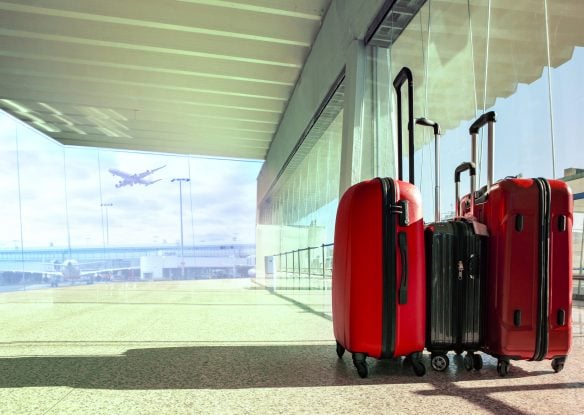Flying with a service dog can be daunting, especially with the recent changes to the Department of Transportation (DOT) rules. But don’t worry; the Trips to Discover team has got you covered! We talked with individuals who regularly travel with service dogs and experts in service dog education to bring you a comprehensive guide that covers everything you need to know about flying with your service dog.
Whether you’re a first-time flier or a seasoned service dog traveler, our guide includes all the latest updates on the Air Carrier Access Act (ACAA), Americans with Disabilities Act (ADA), and individual airline policies. So please sit back, relax, and let us help make your next flight with your service dog a breeze!
Here is a breakdown of everything you will learn on this page:
- Service Dog Definition and Airplane Eligibility
- Service Dog Training Requirements for Flying
- Breed Restrictions and Flying With Large Service Dogs
- New Rules for Flying With a Service Dog
- Service Dog Rights and Laws When Flying
- TSA and Airport Service Dog Policies
- American, Delta, Southwest, United Service Dog Policies
- Service Dog-Proof Airlines Can and Can Not Ask For
- How to Answer Questions About Your Service Dog
- What to Do if Your Service Dog is Denied Aircraft Entry
- Final Tips on Flying With a Service Dog

Service Dog Definition and Airplane Eligibility
A service animal in the US is limited to dogs, individually trained to work or perform tasks for one person with a disability, according to the ADA. On the other hand, emotional support, therapy, comfort, or companion animals provide comfort through their presence. Still, they do not receive special training to perform specific tasks for an individual living with a disability, unlike service dogs trained to do so.
However, ESAs and psychiatric service dogs (PSD) are distinctly different. PSDs are service dogs trained to take specific actions for one person to help avoid certain mental health symptoms. The ADA provides an example to help distinguish the two.
“If the dog has been trained to sense that an anxiety attack is about to happen and take a specific action to help avoid the attack or lessen its impact, the dog is a service animal,” according to the ADA.
As of 2021, the DOT amended the ACAA to align its definition of service animals to match the Department of Justice’s (DOJ) definition in the ADA. According to the ruling, only service dogs are allowed on planes; no other “service” animal would be allowed to board an aircraft. The term “service animal” is synonymous with a “service dog” in the eyes of the ACAA and ADA, as only a dog can be a service animal.

Service Dog Training Requirements for Flying
Service dogs do not need professional training, and users are free to train them, according to the DOT. However, if you are considering preparing your dog to become a service dog, this can be incredibly burdensome. Dog walking and sitting company Rover has some tips to get started on independently making your dog a service dog.
The ADA states that the primary requirement for service dogs is to be trained to perform specific tasks directly related to your disability and nobody else’s.
“A person with diabetes may have a dog that is trained to alert him when his blood sugar reaches high or low levels,” according to the ADA. “A person with depression may have a dog that is trained to remind her to take her medication. Or, a person who has epilepsy may have a dog that is trained to detect the onset of a seizure and then help the person remain safe during the seizure.”
These dogs must be able to focus entirely on you and ignore every other distraction. For additional information on registering a service dog, consult this educational resource from Service Dog Certification.

Breed Restrictions and Flying With Large Service Dogs
The DOT does not restrict service dogs by breed, only that service animals must be dogs. That means a Pitbull, Rottweiler, or Husky can even be a service dog as long as it is individually trained to assist an individual living with a disability with a specific task.
The DOT does not specify weight or size limits for service dogs aboard the aircraft; however, carriers can require a service animal to sit on your lap or within your foot space during a flight. Many airlines elect to impose this requirement mandatorily, so there is, in effect, a size restriction for large dogs inside the aircraft cabin; it would be challenging to fit a Great Dane service dog in your seat’s floor space.
However, the ACAA states that airlines must accommodate large service dogs by moving the passenger and dog to another seat within the same service class, if possible, such as a seat with an adjacent empty seat. If no alternative exists, airlines must provide free transportation service for the service dog in the cargo hold or offer booking on a later flight if more space is available. To prevent an airline from trying to check your large service dog, you can purchase an additional seat in advance, requiring airlines to accommodate large service dogs inside the cabin.

New Rules for Flying With a Service Dog
The DOT enacted a significant overhaul to the ACAA regulations for service animals aboard airplanes, which became effective on 1/11/2021. Here is a summary of the new vital provisions:
-
Only service dogs count as service animals, no other species.
-
Emotional support animals are no longer considered service animals.
-
Only two service animals per passenger living with a disability are allowed on the plane.
-
Airlines can require service animals to fit in a passenger’s foot space or their lap if small.
-
Psychiatric service dogs have the same privileges enacted for other service dogs.
-
Airlines are allowed to require passengers to fill out the DOT’s Service Animal Air Transportation Form (SAATF).
-
Airlines can require passengers to fill out the Service Animal Relief Attestation Form (SARAF) on flights eight hours or longer.
-
Airlines can require passengers to provide either of the two forms above at least 48 hours before the flight if the traveler made the reservation more than 48 hours before the flight.
-
If a traveler makes a reservation within 48 hours of a flight, airlines cannot require this advance documentation and must allow passengers to present the forms at the departure gate.
-
Airlines can require service animals harnessed, leashed, or tethered in airport spaces they own, lease, or control, including the aircraft.

Service Dog Rights and Laws When Flying
See Sight Tours Travel Guide; Jane Jones frequently travels with her service dog in the U.S. and says being aware of your rights and obligations as a traveler with a service animal is essential. Jones pointed to two pieces of legislation that primarily concern service dog travelers.
“Travelers with service animals should be aware of the Americans with Disabilities Act (ADA) and the Air Carrier Access Act (ACAA) regulations,” Jones said. “These laws require that service animals be allowed to accompany their handlers in public places and on airlines, respectively. It is important to note that emotional support animals are not considered service animals under the ADA or the ACAA.”
Arthur Salisbury, the owner of the pit bull and bully information site, PitbullsHome, frequently travels with his 5-year-old pit bull service dog, Horus. Because of the stigma surrounding pit bulls, he has to stay on top of service dog rules and regulations. Salisbury pointed out a few additional legalities and rights that people traveling with service animals should know.
“Airlines must allow service animals to travel with their handlers in the cabin of the aircraft, free of charge,” Salisbury said.
Outside of visual cues, the SAATF and the SARAF, airlines, and businesses, in general, are permitted to ask two questions to verify your service dog, according to Salisbury.
-
Is the animal a service animal required because of a disability?
-
What work or task has the animal been trained to perform?
“However, businesses are not allowed to ask about the person’s disability, require special identification for the animal, or charge additional fees for the service animal’s presence,” Salisubry distinguished. “It’s important to note that laws and regulations regarding service animals can vary by country, so it’s always a good idea to research the laws and policies of your destination before traveling.”

TSA and Airport Service Dog Policies
Flying with a service dog is a unique experience, Salisbury said. However, with proper preparation and knowledge, flying with a service dog can and should be smooth.
“If traveling by air, be sure to make reservations in advance and let the airline know that you will be traveling with a service dog,” Salisbury advised. “This will help the airline make any necessary accommodations and ensure that there is space available for the animal on the flight.”
Nina Clapperton, the founder of Traveling With Your Pets and full-time traveler with a service dog, is well-versed in the laws, regulations, and best practices of traveling with service animals.
Clapperton suggested preparing for additional screenings at the security checkpoint.
“It is best to arrive early at the airport and inform the airline of the service dog’s presence when booking the flight or checking in,” Clapperton said. “At the airport, travelers should expect to go through security screening with their service dog. They should inform the TSA officer if the dog requires any special accommodations during the screening process. Also, some airports have relief areas designated explicitly for service animals.”
Salisbury recommended ensuring you have all necessary supplies for your service dog, like food, water, waste bags, and comfort items — especially in preparation for flight delays, layovers, and connecting flights.
“At the gate, it’s a good idea to inform the gate agent that you will be traveling with a service dog,” Salisbury said. “Even if you have already informed the airline in advance, this will help ensure that the gate agent is aware of any necessary accommodations and can make any last-minute adjustments if needed.”

American, Delta, Southwest, United Service Dog Policies
Most major U.S. airline service dog policies follow the DOT’s guidelines and allowances to the letter, with few discernible differences between individual airlines.
Here are the individual service dog policy pages for the four largest U.S. airlines with direct links to the airline-specific SAATF and SARAF forms with the links for submission:
-
American Airlines: Submit the SAATF and SARAF on this page 48 hours before travel
-
Delta Airlines: Upload the SAATF and SARAF to My Trips 48 hours before travel
-
Southwest Airlines: Bring the SAATF to the ticket counter or gate on travel day
-
Southwest is a more friendly service dog airline as they don’t require the SAATF 48 hours before your flight or the SARAF for eight-hour+ flights.
-
-
United Airlines: Upload the SAATF and SARAF to Trip Details 24 hours before travel

Service Dog-Proof Airlines Can and Can Not Ask For
Airlines primarily use observational signs to determine if a dog is a service dog, such as looking for the presence of vests/harnesses and watching the dog’s behavior, according to the DOT. Airlines are allowed to ask someone living with a disability if the dog is required to accompany the passenger because of disability. They can also ask what work or task the animal has been trained to perform.
According to Clapperton, the primary proof of concern for travelers with service dogs lies in the two DOT forms.
“Airlines may require additional documentation or forms, such as the DOT Service Animal Air Transportation Form or Service Animal Relief Attestation Form,” Clapperton said. “It is best to check with the airline beforehand to ensure compliance with their policies. The former confirms that the dog is a trained service animal and not an ESA, while the latter affirms that the dog will not relieve itself on the plane unless in the designated relief area.”
Salisbury pointed out that airlines can require these forms before travel (typically 48 hours); check the individual airline policy to determine your deadline.
“If the forms are not completed or submitted in a timely manner, the airline may deny boarding to the passenger and their service animal,” Salisbury said. “It’s also a good idea to keep extra copies of the completed forms with you when traveling in case they are requested by airport or airline staff.”
To help clarify the types of proof airline staff are allowed to ask for, Clapperton cited examples of what they are not allowed to ask.
“They are not allowed to ask about the person’s disability, require documentation beyond what is allowed under the ADA, or demand that the dog demonstrates its task,” Clapperton said. “It is good for travelers to know their rights and to advocate for themselves and their service animals if they encounter any illegal or discriminatory practices.”
Although not required, Clapperton highlighted additional documents that would be wise to bring.
“Travelers should bring relevant documents, such as the dog’s health certificate, vaccination records, and proof of training,” Clapperton advised. “However, the ADA does not require service animals to wear a vest or carry any special identification.”
Specific to flying, the DOT does not require service dogs to wear an identifying vest either. However, some laws apply to the control of a service dog.
“Carriers [airlines] are permitted to require a service animal to be harnessed, leashed, or otherwise tethered in areas of the airport that they own, lease, or control, and on the aircraft,” according to the amended ACAA.

How to Answer Questions About Your Service Dog
Receiving attention or questions because of the presence of your service dog can be uncomfortable and intrusive, even if within the legal bounds of what airlines and other businesses are allowed to ask. Jones recommended a few tips for encountering these situations.
“Travelers can best manage uncomfortable interactions by remaining calm and confident in their rights as service animal handlers,” Jones said. “It may be helpful to carry a copy of the ADA and ACAA regulations and to politely but firmly explain the rules surrounding service animal travel.”
Salisbury pointed out that airline staff can only request DOT attestation documentation (the SAATF and SARAF). However, having certification copies can help alleviate concerns in these situations. If you feel that your rights as a passenger traveling with a service animal are being violated, then Salisbury recommends elevating the issue.
“If someone is being particularly difficult or is not following the guidelines set forth by the ADA and DOT, it may be necessary to speak to a supervisor,” Salisbury said. “This can help to resolve the situation and ensure that the traveler’s rights are being respected.”
The DOT requires airlines to make Complaints Resolution Officials (CRO) available to you at no cost upon request in person or by telephone. These individuals are experts on disability accommodation issues. If you feel the problem still needs to be resolved, you can file a complaint online with the airline, which they are legally obligated to respond to within 30 days. Finally, you can file a complaint with the DOT if none of the other avenues have resolved the problem.

What to Do if Your Service Dog is Denied Aircraft Entry
According to the DOT, airlines are allowed to deny transportation of your service dog if your dog violates safety requirements or poses a direct threat to the health and safety of others. Airlines can also deny entry for a service dog if it violates another health requirement, like being prohibited from entering another country.
Additionally, airlines can refuse service if you do not provide the required DOT SAAT and SARA forms.
If you find yourself in a situation where an airline denies your service dog entry to the aircraft outside the allowances above, Salisbury advises taking an educational approach first.
“Explain that you have rights under the Americans with Disabilities Act (ADA) and the Department of Transportation (DOT) regulations, and request that the airline comply with these rights,” Salisbury said. “Show the necessary documentation to demonstrate that your dog is a service animal. Request to speak to a supervisor as they may have more knowledge and authority to resolve the situation.”
Jones laid out some best next steps if educating airline staff does not work when you believe an airline improperly denies your service dog entry to the aircraft.
“If an airline denies boarding a service animal, the handler should ask for a written explanation of the decision and report the incident to the Department of Transportation (DOT) and the airline’s disability desk,” Jones said. “It may also be helpful to contact a disability rights organization for assistance.”

Final Tips on Flying With a Service Dog
According to Salisbury, managing airport navigation with a service dog begins before you enter the airport.
“When booking your flight, it’s a good idea to notify the airline in advance that you will be traveling with a service dog,” Salisbury said. “Arriving early at the airport will give you extra time to check in with the airline, go through security, and navigate any other necessary processes. This will help reduce stress for both you and your service dog.”
Although vests are not required, Salisbury recommends using one to make the process smoother and help airline staff immediately identify your dog as a service dog.
“It’s important to keep your service dog under control at all times,” Salisbury said. “This may include using a leash, harness, or other appropriate equipment, as well as training your dog to stay calm and well-behaved in busy and noisy environments.”
Salisbury also recommends having an emergency plan in place for your service dog.
“This could include identifying an emergency contact who can care for your dog if you are unable to do so and having an emergency kit on hand with food, water, and any necessary medications,” Salisbury said.



















































